WIT Life #94: Beard Papa and other familiar favorites
WITLife is a periodic series written by professional Writer/Interpreter/Translator Stacy Smith (Kumamoto-ken CIR, 2000-03). She starts her day by watching Fujisankei’s newscast in Japanese, and here she shares some of the interesting tidbits and trends together with her own observations.
Today is our last full day in San Francisco, so I decided to explore some of the offerings in the immediate vicinity of where I am staying, Hotel Nikko. Here in the lobby there are so many Japanese customers that I occasionally get flashbacks to the many times I spent in Kumamoto’s Hotel Nikko at various events during my time on JET. Natsukashii!
I went for a walk to the local mall with my co-interpreter who was on a mission to find cream puffs. I had no idea that Beard Papa had an outpost here on the West Coast, but sure enough Read More
WITLife is a periodic series written by professional Writer/Interpreter/Translator Stacy Smith (Kumamoto-ken CIR, 2000-03). She starts her day by watching Fujisankei’s newscast in Japanese, and here she shares some of the interesting tidbits and trends together with her own observations.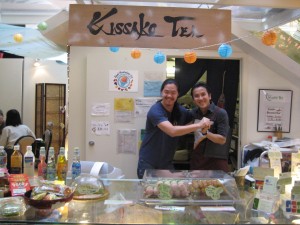
My interpreting travels bring me to San Francisco this time, and I couldn’t leave without paying a visit to Japantown. I hadn’t been there in a couple of years, but I clearly remembered the array of restaurants, souvenir shops and an onsen-like spa I once had a soak in. I went with a friend who was craving something sweet and wanted a recommendation, so I suggested we get 白玉汁粉 (shiratama shiruko), one of my favorite Japanese desserts following ぜんざい (zenzai). We ended up at Kissako Tea where we were served by Hiro and Koji, pretending to be a charming 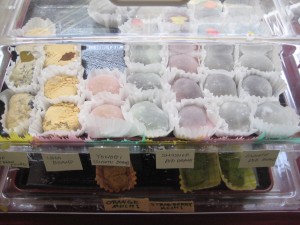 couple in the picture on the right.
couple in the picture on the right.
Kissako also had a nice selection of mochi (pictured left), including Read More
WITLife is a periodic series written by professional Writer/Interpreter/Translator Stacy Smith (Kumamoto-ken CIR, 2000-03). She starts her day by watching Fujisankei’s newscast in Japanese, and here she shares some of the interesting tidbits and trends together with her own observations.
Last week there was an interesting article in the NYT about Chinese teachers who are sponsored by their  government (with additional support from local school districts) to come teach here in the States for up to three year. It reminded me of JET, as well as my own experience first learning Japanese in high school. The article featured a young woman teaching in rural Oklahoma, and the cultural roadblocks she encountered along the course of her job (American students lack of geographical knowledge, pregnant teenagers, etc.). I love the quote she provides at the end of the article regarding what she hopes to impart to her students: “I want my students to have a sweet, sweet memory of taking Chinese. They won’t remember a lot of words, but I want them to remember the beauty of the language and the culture.”
government (with additional support from local school districts) to come teach here in the States for up to three year. It reminded me of JET, as well as my own experience first learning Japanese in high school. The article featured a young woman teaching in rural Oklahoma, and the cultural roadblocks she encountered along the course of her job (American students lack of geographical knowledge, pregnant teenagers, etc.). I love the quote she provides at the end of the article regarding what she hopes to impart to her students: “I want my students to have a sweet, sweet memory of taking Chinese. They won’t remember a lot of words, but I want them to remember the beauty of the language and the culture.”
It calls to mind the power of teachers and how a good one can have a dramatic effect on your future. As for me personally, I can definitely say that I would not be where I am today without the existence of my amazing high school Japanese teacher, Sensei Watson. It was her unique teaching style and incorporation of non-traditional methods, like showing us 紅白歌合戦 (kouhaku uta gassen or New Year’s Eve Singing Content) and having us write 年賀状 (nengajou or New Year’s greeting cards) before Oshougatsu that initially made me curious about this country that seemed to be so different from my own. I am eternally grateful to her for getting me started on my lifelong journey of discovering Japan!
WIT Life #91: More than just mochi
WITLife is a periodic series written by professional Writer/Interpreter/Translator Stacy Smith (Kumamoto-ken CIR, 2000-03). She starts her day by watching Fujisankei’s newscast in Japanese, and here she shares some of the interesting tidbits and trends together with her own observations.
I have already written about my obsession with Kansai Yamato, an amazing mochi maker located in Honolulu’s Ala Moana mall. I am lucky enough to be back in Hawaii with my current group (someone up there likes me!), so of course I had to pay a visit as soon as I got into town. As the shelves were fully stocked, I was able to find some items I had not seen before. In addition to the wide variety of mochi, they had some other goodies like the kabocha bread in the picture on the right. As a huge pumpkin fan, I had to try it. I was expecting something along the lines of Japan’s mushi pan (steamed bread), but it was more substantial, similar to the consistency of a moist muffin (shittori shite iru). These two large piec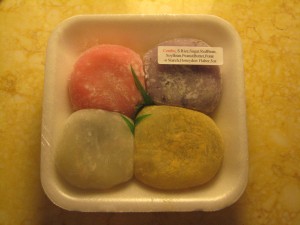 es cost $2.99 plus tax, well worth the price.
es cost $2.99 plus tax, well worth the price.
Aside from getting some of the unusual flavors that I come to Kansai Yamato for (peanut butter & chocolate, Oreo, etc.), I got a mochi sampler ($3.99 plus tax) that included a variety of types. Shown on the left, it is comprised of (from top left clockwise) peanut butter, Okinawan sweet potato, kinako with red bean paste and what is labeled as honeydew (though it’s not very green in color). Clearly my sweet tooth will be satisfied for the next few days…
WIT Life #90: 感謝の気持ち
WITLife is a periodic series written by professional Writer/Interpreter/Translator Stacy Smith (Kumamoto-ken CIR, 2000-03). She starts her day by watching Fujisankei’s newscast in Japanese, and here she shares some of the interesting tidbits and trends together with her own observations.
Following our time in America’s heartland my group and I have since moved to the Bay Area, where we are continuing our study of food safety here in the States. One participant requested that we go to eat at a vegan restaurant, as this is not a common concept in Japan. In fact, one night we had a heated conversation regarding the distinction made between the values of plant/animal lives, as well as the viab ility of vegetarianism. Veganism was a whole other extreme for them, but as they say, don’t knock it till you’ve tried it. So we were off to San Francisco’s Cafe Gratitude.
ility of vegetarianism. Veganism was a whole other extreme for them, but as they say, don’t knock it till you’ve tried it. So we were off to San Francisco’s Cafe Gratitude.
My participants were surprised at how delicious all the food was despite the limited ingredients. We had a sampler which included Read More
WIT Life #89: 空気人形
WITLife is a periodic series written by professional Writer/Interpreter/Translator Stacy Smith (Kumamoto-ken CIR, 2000-03). She starts her day by watching Fujisankei’s newscast in Japanese, and here she shares some of the interesting tidbits and trends together with her own observations.
My current DOS interpreting assignment regarding food safety has kept me busy, but a weekend here in the farm country of Illinois has allowed some time to catch up. When I was in DC earlier this week, the annual Filmfest featuring a variety of international films was taking place. While flipping through the program booklet, I was happy to find that the latest release of one of my favorite Japanese directors, Hirokazu Kore-eda, was being screened. Some of his well-known previous works are After Life (ワンダフルライフ), Nobody Knows (誰も知らない) and Still Walking (歩いても 歩いても), and his newest is Air Doll (空気人形).
This two-hour plus movie came out in Japan last year, and it is based on Read More
**********************************************
WITLife is a periodic series written by professional Writer/Interpreter/Translator Stacy Smith (Kumamoto-ken CIR, 2000-03). She starts her day by watching Fujisankei’s newscast in Japanese, and here she shares some of the interesting tidbits and trends together with her own observations.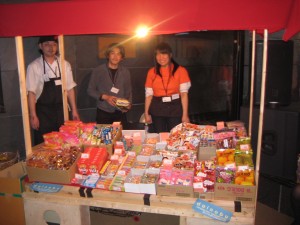
This weekend Japan Society hosted the inaugural 12-hour extravaganza known as “j-cation”. The line-up of events was kicked off by the movie Flavor of Happiness (幸せの香り or Shiawase no kaori), the story of a father-daughter relationship between an aging Chinese chef and his young female apprentice. A bit long and sappy, but the food images were to die for! In various corners of Japan Society several workshops were simultaneously taking place, such as Read More
WITLife is a periodic series written by professional Writer/Interpreter/Translator Stacy Smith (Kumamoto-ken CIR, 2000-03). She starts her day by watching Fujisankei’s newscast in Japanese, and here she shares some of the interesting tidbits and trends together with her own observations.
The other night I had the pleasure of meeting the author Jake Adelstein (pictured here on the Daily Show) who wrote the sensational book Tokyo Vice, the story of his time as a crime reporter in Japan. This absorbing memoir traces his path from Sophia University student to full-time reporter at the newspaper Yomiuri Shimbun, a notable feat for a foreigner. He spent 12 years covering the underbelly of Japan, and as expected the bulk of his talk concentrated on the yakuza.
He discussed how this Japanese mafia is known as a second police force, or a necessary evil (必要な悪 or hitsuyou na aku). As tracked by the police they number Read More
WIT Life #86: 日本の企業家精神
WITLife is a periodic series written by professional Writer/Interpreter/Translator Stacy Smith (Kumamoto-ken CIR, 2000-03). She starts her day by watching Fujisankei’s newscast in Japanese, and here she shares some of the interesting tidbits and trends together with her own observations.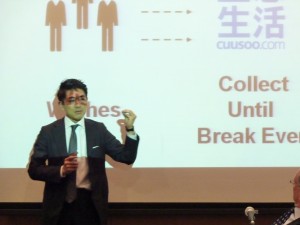
Last night I attended a symposium on Entrepreneurship in Japan (日本の企業家精神; nihon no kigyouka seishin) hosted by the Columbia Business School’s Center on Japanese Economy and Business. The three panelists (two present, one via video from Tokyo) represented a variety of generations and backgrounds. In 1985, American-born Ernest Matsuo Higa revolutionized Japanese home pizza delivery after obtaining the exclusive license to Domino’s Pizza. Atsushi Imuta (participating from Tokyo) quit his job at a Japanese bank to found RISA Partners, an invesment banking firm. Kohei Nishiyama, the youngest of the group who was raised in Columbia and went to university in Japan, invented the Design To Order system which allows manufacturers to reduce risk by carrying out product development based on customers’ requests.
An article on Japanese entrepreneurship in last month’s Eurobiz Japan highlights how within the Japan’s educational system there is the idea of Read More
WIT Life #85: New start
WITLife is a periodic series written by professional Writer/Interpreter/Translator Stacy Smith (Kumamoto-ken CIR, 2000-03). She starts her day by watching Fujisankei’s newscast in Japanese, and here she shares some of the interesting tidbits and trends together with her own observations.
Whereas here in the States today we celebrate April Fool’s Day, April 1st in Japan is a beginning. It is the start of the new fiscal and school years, and the blooming and subsequent falling of the cherry blossoms serves as a way to mark this transition. This morning’s news outlined several changes that will be taking place in accordance with the new year, but whether they will make life in Japan easier or harder remains to be seen.
- The child allowance law giving parents 13,000 yen per child per month goes into effect today, fulfilling one of the DPJ’s key campaign pledges. It differs from Read More
WIT Life #84: 国勢調査
**********************************************************************
WITLife is a periodic series written by professional Writer/Interpreter/Translator Stacy Smith (Kumamoto-ken CIR, 2000-03). She starts her day by watching Fujisankei’s newscast in Japanese, and here she shares some of the interesting tidbits and trends together with her own observations.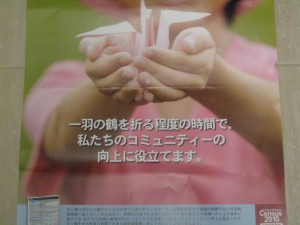
We are rapidly coming up on the deadline for the 国勢調査 (kokusei chousa) or national census, so I hope everyone has already filled in and returned their forms. Every morning during the Japanese news there are advertisements running in Japanese advocating participation in the census as one’s civic duty. Also, I have come across some interesting Japanese language print ads that I would like to share.
The one on the right shows Read More
WIT Life #83: Japan in the news and in film
WITLife is a periodic series written by professional Writer/Interpreter/Translator Stacy Smith (Kumamoto-ken CIR, 2000-03). She starts her day by watching Fujisankei’s newscast in Japanese, and here she shares some of the interesting tidbits and trends together with her own observations.
The Wall Street Journal had some interesting Japan coverage this week. One article from earlier in the week discusses tactics being employed to get the Japanese populace turned on to fish again, as its popularity has declined due to factors such as smell, price and preparation. It has gotten to the point where fishery officials have started sending instructors to schools in order to teach children how to eat fish with chopsticks, and fish is being promoted in pop culture by characters such as Sakana-kun (on right saying “Let’s eat delicious fish with Sakana-kun!”).
Another article focuses on Japanese-Americans who were interned during WWII, and how they got through this ordeal by forming swing bands. This legacy is being preserved through a tribute band called Minidoka Swing Band, with members who were internees as well as others who have no ties to the camps (check out the video, they’re talented!).
Speaking of the internment, this weekend was the 3rd annual New York Peace Film Festival which featured Read More
WIT Life #82: 春分の日
WITLife is a periodic series written by professional Writer/Interpreter/Translator Stacy Smith (Kumamoto-ken CIR, 2000-03). She starts her day by watching Fujisankei’s newscast in Japanese, and here she shares some of the interesting tidbits and trends together with her own observations.![GetAttachment[3]](http://jetwit.com/wordpress/wp-content/uploads/2010/03/GetAttachment3-300x225.jpg)
Happy 春分の日 (shunbun no hi) or Spring Equinox Day! Like as with the autumnal equinox, on this occasion the day and the night should be of equal length. The mere mention of spring makes me feel like I should be seeing flowers popping their heads out of the ground. Unfortunately, here in Michigan where I’m translating at a local law firm there is no sign of greenery, although the snow flurries we had all day yesterday were quite a sight! I heard we’re getting much better weather back home in NYC, and![GetAttachment[2]](http://jetwit.com/wordpress/wp-content/uploads/2010/03/GetAttachment2-300x225.jpg) all I can say is I’m jealous…
all I can say is I’m jealous…
In Japan spring seems to have sprung, as I have gotten reports of the sakura beginning to bloom around the Imperial Palace. I also just received an email from my former co-worker at the Kumamoto International Center who was kind enough to send pictures of the sakura down south (you can see Kumamoto Castle in the background). Enjoy and happy spring!
Jamie Graves: Food translator and waiter at Kajitsu NYC
 By Steven Horowitz (Aichi-ken, 1992-94)
By Steven Horowitz (Aichi-ken, 1992-94)
Just wanted to share that I had a really terrific dinner the other night at Kajitsu (www.kajitsunyc.com), a new and very unique Japanese restaurant on E. 9th Street in NYC, thanks to professional translator Jamie Graves (Saitama-ken, 2002-03) who not only waits tables in the intimate establishment but also translates the menu and other texts for Kajitsu and interprets for important clients.
Jamie, who specializes in translations relating to food and cooking, explained to me a few months ago at a JETAA NY gathering that he was working at a restaurant that specializes in shojin cuisine, which as a non-foodie I can best describe as a sort of high-end, vegan kaiseki. The chef, Masato Nishihara, had worked at Kitcho, a very prestigious kaiseki cuisine restaurant in Kyoto before coming to New York to open Kajitsu.
I can’t remember exactly what I ate, but each course did really blow me away in terms of both flavors and creativity. Plus the soba dipping noodles may be the best in NYC. The menu changes every month, so apparently a number of regulars come back each month to sample the new menu.
The fare is not inexpensive. But it’s well worth it if you have a special occasion to celebrate (which I did!) Especially if you get a seat at the counter where you can watch Chef Nishihara prepare each course right front of you, including his zen-like tea ceremony approach to making the macha at the end of the meal. (According to Jamie, all chefs at Kitcho must study tea ceremony.)
Here’s a little additional background on Kajitsu from it’s website:
Kajitsu – “Fine Day”
Kajitsu means “fine day”, or “day of celebration” in Japanese. We have chosen the name Kajitsu hoping that a visit here will always be a special occasion for our guests.Shojin Cuisine
Shojin cuisine refers to a type of vegetarian cooking that originates in Zen Buddhism. Even though it does not use meat or fish, shojin is regarded as the foundation of all Japanese cuisine, especially kaiseki, the Japanese version of haute cuisine.
If you decide you have your own special occasion, make sure to say hi to Jamie and ask him all of your questions about the restaurant and the food. There’s lots to tell and lots to learn.
Kajitsu (www.kajitsunyc.com) is on E. 9th St between 1st Ave & Avenue A in New York City.
WIT Life #81: Japanese high school tuition
WITLife is a periodic series written by professional Writer/Interpreter/Translator Stacy Smith (Kumamoto-ken CIR, 2000-03). She starts her day by watching Fujisankei’s newscast in Japanese, and here she shares some of the interesting tidbits and trends together with her own observations.
There is a bit of a controversy brewing over implementation of one aspect of the DPJ’s Manifesto. This is the proposal of free tuition for high schools currently being debated in the Diet. Students have to pay to attend high school as Japanese education is only compulsory through junior high. The question here is whether North Korean schools in Japan (of which there are 10 and where about 2,000 students of both North Korean and South Korean nationality are enrolled) should be similarly subsidized considering that Japan imposes economic sanctions on North Korea and in light of the yet unresolved abduction issue.
PM Hatoyama is waffling on this issue, with him initially Read More



